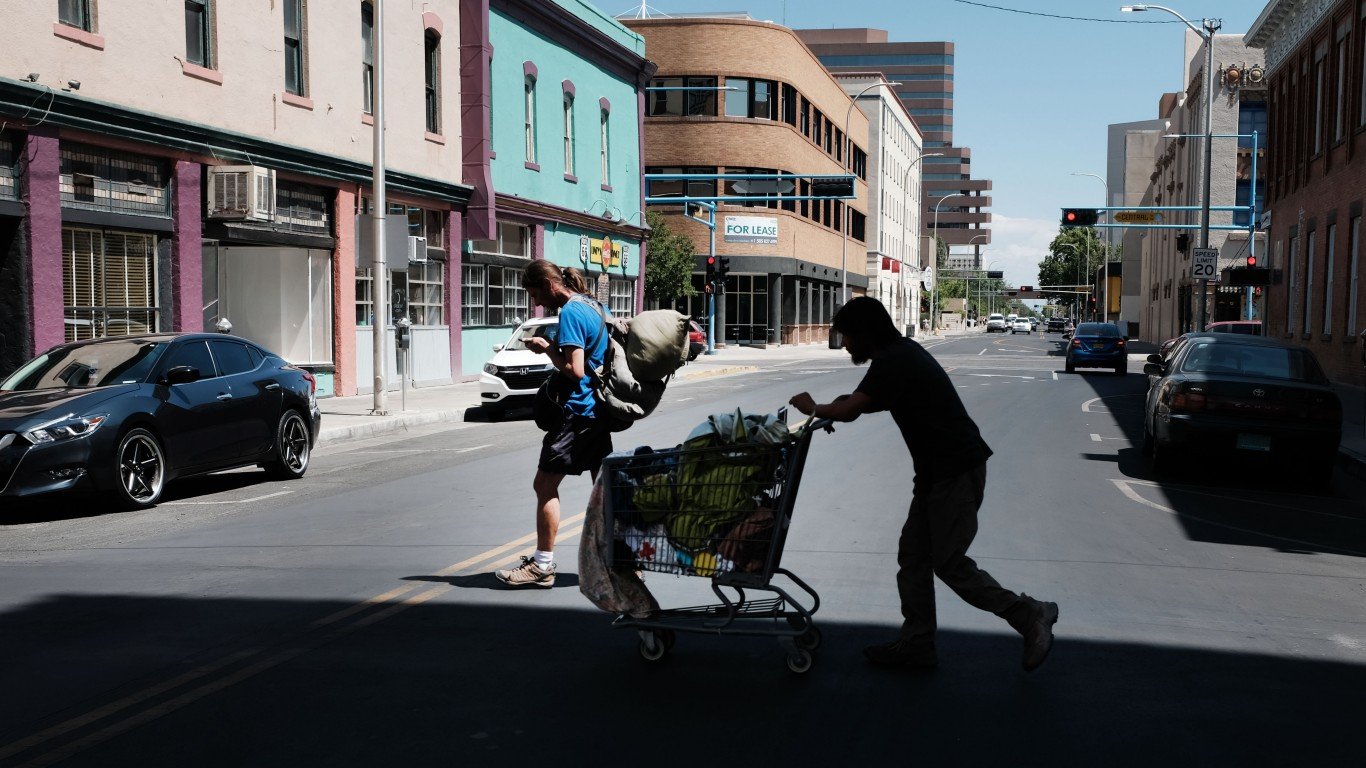

Property crime is a category of non-violent offenses comprising three subcategories: burglary, larceny theft, and motor vehicle theft. According to the FBI, a total of 6.9 million property crimes were committed in the United States in 2019. The total value of goods stolen — ranging from clothing and jewelry to firearms and motor vehicles — is estimated $14.3 billion.
Adjusting for population, there were a total of 2,110 property crimes for every 100,000 people in the United States in 2019. Of course, crime is a highly local phenomenon, and as a result, property crime rates vary substantially from state to state and city to city.
Using data from the FBI’s 2019 Uniform Crime Report, 24/7 Wall St. identified the city or town with the highest property crime rate in each state. In every state — even those where crime rates are low — there is at least one municipality where the population-adjusted property crime rate exceeds the comparable national rate.
Larceny-theft, defined as the unlawful taking of property, often in the form of shoplifting or pickpocketing, is the most common form of property crime in the United States, accounting for about three in every four offences. Burglary, which is the illegal entry of a structure to commit a crime, and motor-vehicle theft, which can be either the theft or the attempted theft of a vehicle, together account for about one in every four property crimes nationwide. Here is a look at where your car is most likely to be stolen in every state.
Click here to see the American city with the most property crime in every state.
To determine the cities with the most property crime in every state, 24/7 Wall St. reviewed property crime data from the FBI’s 2019 Uniform Crime Report. We ranked cities based on the number of property crimes reported per 100,000 residents. We considered all cities, towns, villages, and Census designated places home to at least 20,000 people in our analysis. Alabama and Hawaii did not have sufficient crime data at the city level and were excluded from our analysis. Data on poverty rate came from the U.S. Census Bureau’s American Community Survey and are five-year averages for 2019.
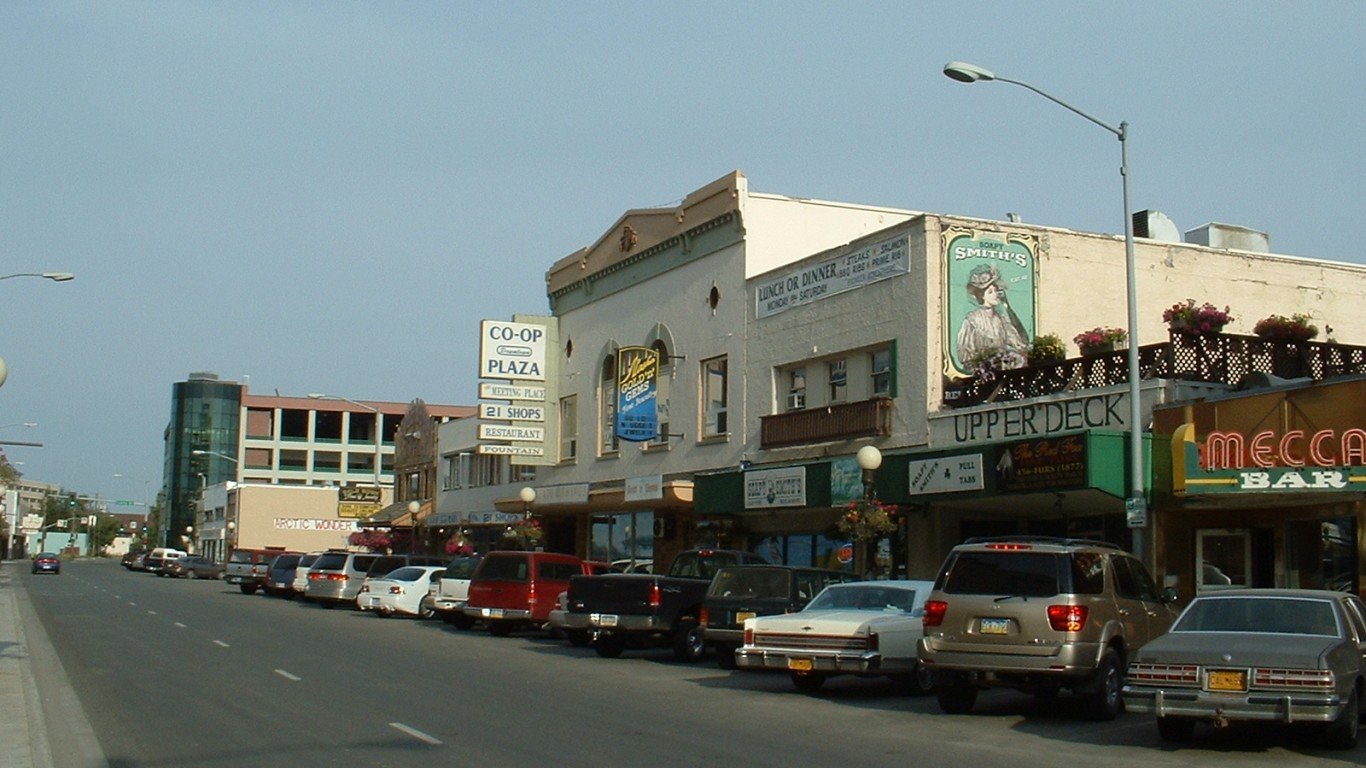
Alaska: Fairbanks
> 2019 property crimes per 100,000 people: 4,296 (state: 2,079)
> Number of property crimes in 2019: 1,353 (6.4% of state total)
> Burglaries in 2019: 163 (4.6% of state total)
> Vehicle thefts in 2019: 184 (7.0% of state total)
> Poverty rate: 11.0% (state: 10.7%)
The FBI tracks property crime in three Alaska cities that are home to at least 20,000 people. Of them, Fairbanks has the highest property crime rate. A total of 1,353 property crimes were reported in the city in 2019, or 4,296 for every 100,000 people — more than double the comparable property crime rate across the entire state of 2,079 per 100,000.
Though property crime is more common in Fairbanks than it is in either Anchorage or Juneau — the other two large Alaskan cities tracked by the FBI — other more serious crimes are less common in the city. There were 784 violent crimes, such as robbery and homicide, reported per 100,000 people in Fairbanks in 2019, a lower rate than in either Juneau or Anchorage.
[in-text-ad]

Arizona: Kingman
> 2019 property crimes per 100,000 people: 4,386 (state: 1,336)
> Number of property crimes in 2019: 1,342 (0.8% of state total)
> Burglaries in 2019: 208 (0.7% of state total)
> Vehicle thefts in 2019: 95 (0.5% of state total)
> Poverty rate: 14.3% (state: 15.1%)
Kingman, a city of about 30,600 people in northwestern Arizona, has a higher concentration of property crime than any of the 31 cities in the state home to at least 20,000 people tracked by the FBI. There were 4,386 reported property crimes for every 100,000 people in the city in 2019, more than triple the state property crime rate.
As is the case nationwide, larceny-theft is by far the most commonly reported crime in Kingman. More than three in every four property crimes committed in the city in 2019 were categorized as larceny. The remaining incidents were either burglary or motor vehicle theft.

Arkansas: Hot Springs
> 2019 property crimes per 100,000 people: 7,176 (state: 2,682)
> Number of property crimes in 2019: 2,674 (3.1% of state total)
> Burglaries in 2019: 755 (4.2% of state total)
> Vehicle thefts in 2019: 209 (2.8% of state total)
> Poverty rate: 24.3% (state: 17.0%)
The property crime rate of 7,176 incidents for every 100,000 people in Hot Springs, Arkansas, is the highest of any city in the state and one of the highest in the United States. For reference, the property crime rate across all of Arkansas stands at 2,682 per 100,000 people.
Property crimes are typically committed for monetary gain, and many in Hot Springs are struggling financially. The local poverty rate of 24.3% is well above both the 17.0% state and 13.4% national poverty rates.

California: Oakland
> 2019 property crimes per 100,000 people: 6,421 (state: 1,847)
> Number of property crimes in 2019: 27,868 (3.0% of state total)
> Burglaries in 2019: 2,599 (1.7% of state total)
> Vehicle thefts in 2019: 5,041 (3.6% of state total)
> Poverty rate: 16.7% (state: 13.4%)
Oakland is home to only about 1% of California’s total population, yet 3% of all property crimes in the state are committed there. There were 6,421 property crimes reported for every 100,000 people in Oakland in 2019, more than triple the state property crime rate of 1,847 per 100,000.
The city’s high property crime rate is driven by cases of larceny and motor vehicle theft. However, nearly two dozen other California cities have higher burglary rates than Oakland.
[in-text-ad-2]
Colorado: Englewood
> 2019 property crimes per 100,000 people: 5,225 (state: 2,911)
> Number of property crimes in 2019: 1,843 (1.2% of state total)
> Burglaries in 2019: 108 (0.5% of state total)
> Vehicle thefts in 2019: 303 (1.4% of state total)
> Poverty rate: 13.7% (state: 10.3%)
Englewood is a small Colorado city of about 35,300 residents located just south of Denver. Its property crime rate of 5,225 incidents per 100,000 people is the highest of any city in the state. For context, across all of Colorado, there were 2,911 property crimes for every 100,000 people in 2019.
Despite the relatively high concentration of property crimes, other, more serious, crimes such as robbery and homicide are less common in Englewood than in much of the rest of the state. A total of 204 violent crimes for every 100,000 people were reported locally in 2019, compared to 381 per 100,000 statewide.

Connecticut: New Haven
> 2019 property crimes per 100,000 people: 3,799 (state: 2,858)
> Number of property crimes in 2019: 4,958 (9.7% of state total)
> Burglaries in 2019: 659 (10.2% of state total)
> Vehicle thefts in 2019: 719 (12.1% of state total)
> Poverty rate: 26.5% (state: 9.9%)
The FBI maintains crime statistics for 53 cities and towns in Connecticut that are home to at least 20,000 people. Of them, 51 have a lower property crime rate than the statewide rate of 2,858 incidents per 100,000 people. New Haven, with a state-leading property crime rate of 3,799 incidents per 100,000 people, is driving up Connecticut’s property crime rate. New Haven is home to only 3.7% of the state’s population, but reported 9.7% of all property crimes committed in the state in 2019.
Property crimes are typically committed for monetary gain, and many in New Haven are struggling financially. The local poverty rate of 26.5% is well above both the 9.9% state and 13.4% national poverty rates.
[in-text-ad]
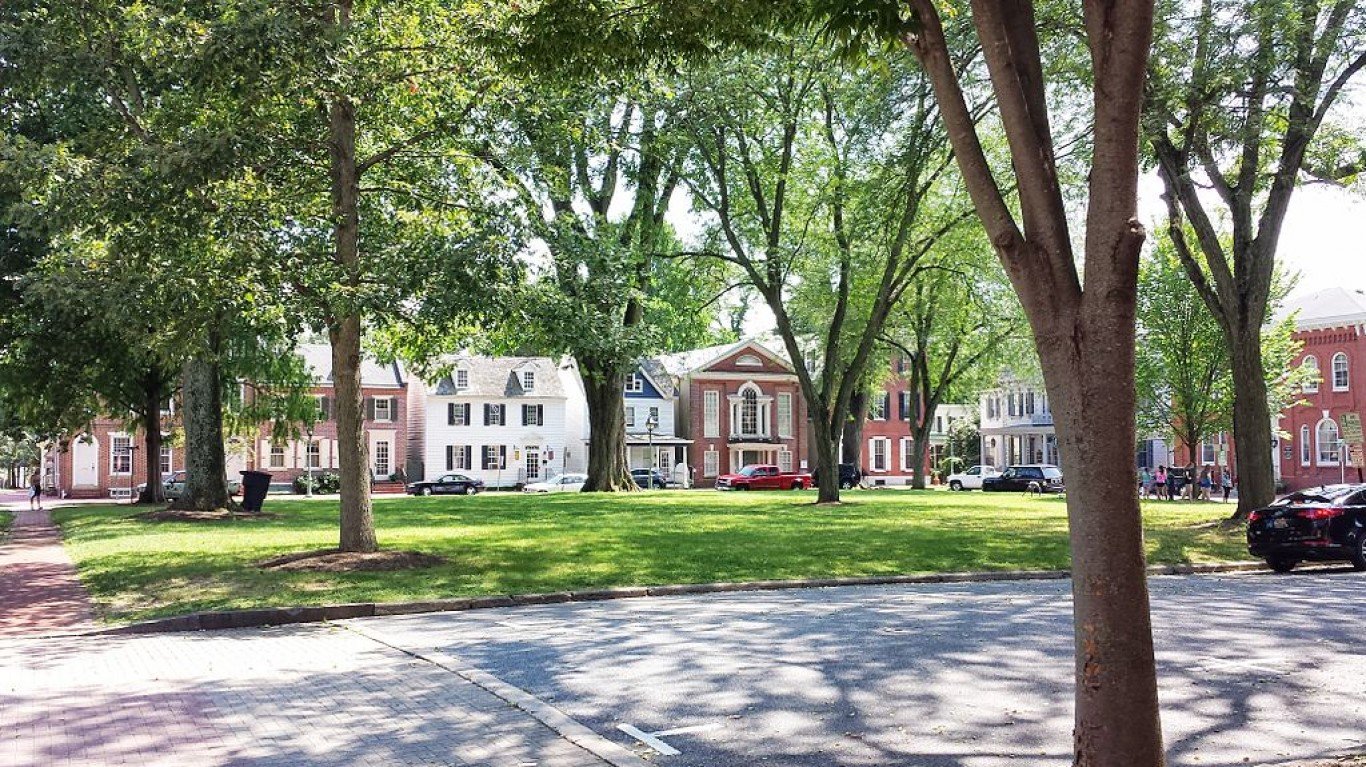
Delaware: Dover
> 2019 property crimes per 100,000 people: 5,362 (state: 2,639)
> Number of property crimes in 2019: 2,057 (9.4% of state total)
> Burglaries in 2019: 82 (2.8% of state total)
> Vehicle thefts in 2019: 89 (5.5% of state total)
> Poverty rate: 24.4% (state: 11.8%)
Dover has a higher concentration of property crime than any other city in Delaware. Home to only about 3.9% of the state population, Dover is also where nearly 10% of all property crime in the state is committed. The local property crime rate of 5,362 per 100,000 people is double the state property crime rate of 2,639 per 100,000.
Areas with higher than average property crime rates are often home to relatively large populations facing serious financial hardship — and Dover is no exception. The local poverty rate of 24.4% is more than double the statewide poverty rate of 11.8%.

Florida: Miami Beach
> 2019 property crimes per 100,000 people: 7,568 (state: 2,193)
> Number of property crimes in 2019: 6,977 (1.5% of state total)
> Burglaries in 2019: 717 (1.1% of state total)
> Vehicle thefts in 2019: 366 (0.9% of state total)
> Poverty rate: 14.0% (state: 14.0%)
Miami Beach, Florida, is located on a barrier island between Miami and the Atlantic Ocean. Popular tourist destinations, like Miami Beach, can often have inflated crime rates as visitors — who are not counted in the population total — can be both victims and perpetrators of criminal activity. Of the 112 cities in Florida tracked by the FBI and home to at least 20,000 people, Miami Beach has the highest property crime rate. There were 7,568 incidents reported for every 100,000 people in the city in 2019, about three and a half times greater than the statewide property crime rate of 2,193 per 100,000.
Other more serious crimes such as robbery and aggravated assault are also more common in Miami Beach than across Florida as a whole.
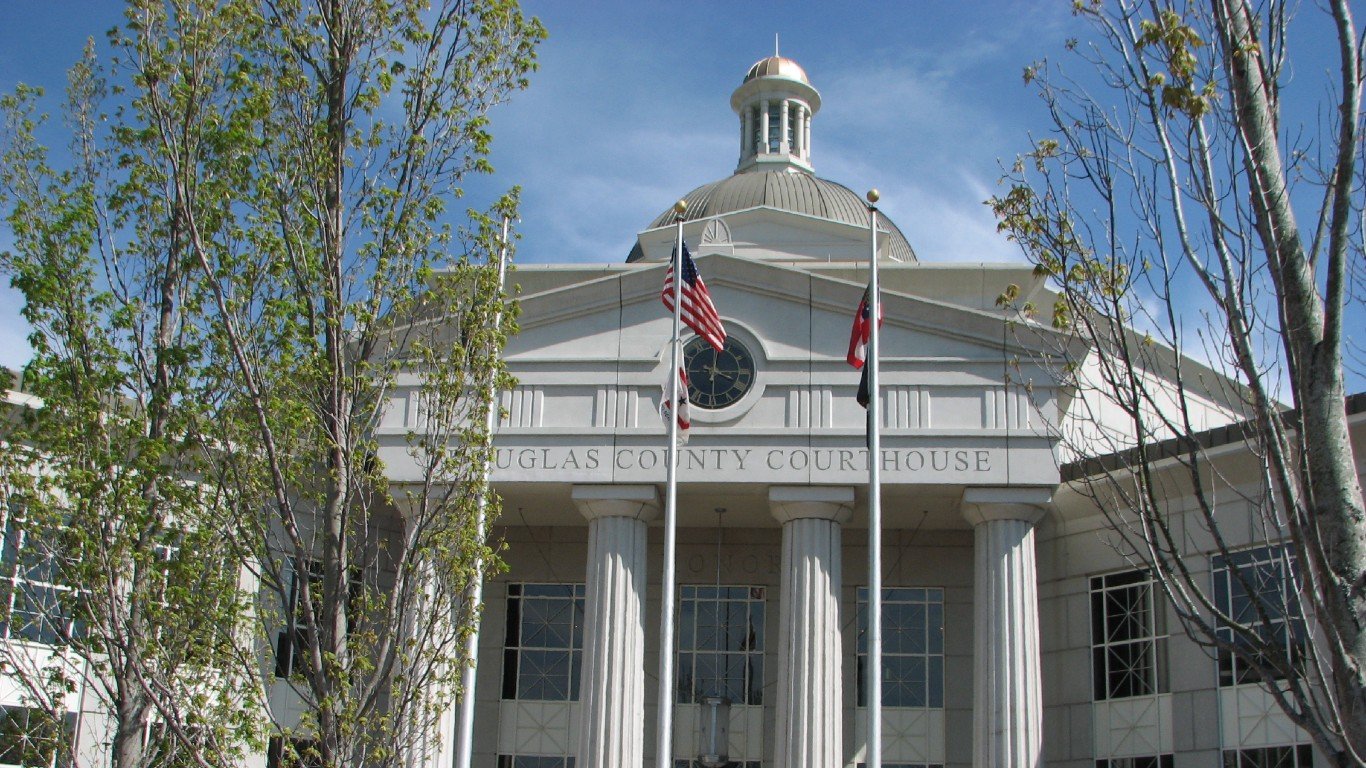
Georgia: Douglasville
> 2019 property crimes per 100,000 people: 5,816 (state: 2,056)
> Number of property crimes in 2019: 2,013 (0.8% of state total)
> Burglaries in 2019: 135 (0.3% of state total)
> Vehicle thefts in 2019: 73 (0.3% of state total)
> Poverty rate: 12.5% (state: 15.1%)
Douglasville is a city of about 35,000 in northern Georgia just west of Atlanta. With a property crime rate of 5,816 incidents per 100,000 people, Douglasville is the only city in Georgia with a population of at least 20,000 with a property crime rate over 5,000 per 100,000. Across the state as a whole, there were 2,056 property crimes for every 100,000 people in 2019.
As is the case nationwide, larceny accounts for the bulk of property crimes reported in Douglasville. Nearly 90% of the 2,013 known incidents in the city in 2019 were cases of larceny.
[in-text-ad-2]

Idaho: Lewiston
> 2019 property crimes per 100,000 people: 2,900 (state: 1,209)
> Number of property crimes in 2019: 955 (4.4% of state total)
> Burglaries in 2019: 145 (3.7% of state total)
> Vehicle thefts in 2019: 55 (3.5% of state total)
> Poverty rate: 13.1% (state: 13.1%)
Lewiston, located in northwestern Idaho, has the highest property crime rate in the state. There were a total of 2,900 property crimes reported for every 100,000 people in the city in 2019, more than double the state property crime rate of 1,209 per 100,000.
Of the 12 cities in Idaho with comparable data, Lewiston has the highest burglary and larceny rates and the second highest motor vehicle theft rate.

Illinois: Lansing
> 2019 property crimes per 100,000 people: 5,423 (state: 3,162)
> Number of property crimes in 2019: 1,495 (0.6% of state total)
> Burglaries in 2019: 130 (0.4% of state total)
> Vehicle thefts in 2019: 106 (0.6% of state total)
> Poverty rate: 15.5% (state: 12.5%)
Lansing is a city of about 28,000 in northeastern Illinois. Nearly 1,500 property crimes were reported in the city in 2019, or 5,423 for every 100,000 people, more than every other comparable city in the state.
As is often the case, larceny is the most commonly reported type of property crime in Lansing, accounting for just over 84% of all known property crimes.
[in-text-ad]
Indiana: Clarksville
> 2019 property crimes per 100,000 people: 5,839 (state: 1,535)
> Number of property crimes in 2019: 1,263 (1.0% of state total)
> Burglaries in 2019: 80 (0.4% of state total)
> Vehicle thefts in 2019: 81 (0.6% of state total)
> Poverty rate: 12.3% (state: 13.4%)
Clarksville, Indiana, is a town of about 21,600 residents located just north of Louisville, Kentucky. With a property crime rate of 5,839 incidents per 100,000 people, Clarksville is the only city in Indiana with a population of at least 20,000 with a property crime rate over 5,000 incidents per 100,000 people. Across the state as a whole, there were just 1,535 property crimes for every 100,000 people in 2019.
Only about 13% of the 1,263 property crimes committed in Clarksville in 2019 were burglaries or motor vehicle thefts. The vast majority were cases of larceny.

Iowa: Council Bluffs
> 2019 property crimes per 100,000 people: 5,845 (state: 2,039)
> Number of property crimes in 2019: 3,649 (6.7% of state total)
> Burglaries in 2019: 529 (4.5% of state total)
> Vehicle thefts in 2019: 491 (9.5% of state total)
> Poverty rate: 12.8% (state: 11.5%)
Council Bluffs’s property crime rate of 5,845 incidents per 100,000 people is by far the highest of any city or town of at least 20,000 people in Iowa. For context, there were 2,039 property crimes for every 100,000 people across the entire state in 2019, and just 602 per 100,000 in North Liberty, the Iowa city with the lowest property crime rate.
Council Bluffs is home to only 2% of Iowa’s population — yet nearly 7% of all property crimes in the state in 2019 were committed there.

Kansas: Wichita
> 2019 property crimes per 100,000 people: 5,322 (state: 1,585)
> Number of property crimes in 2019: 20,759 (30.8% of state total)
> Burglaries in 2019: 2,677 (26.8% of state total)
> Vehicle thefts in 2019: 2,305 (31.7% of state total)
> Poverty rate: 15.9% (state: 12.0%)
The property crime rate of 5,322 incidents per 100,000 people in Wichita is the highest of any city in Kansas and more than three times the state property crime rate of 1,585 incidents per 100,000 people.
Other, more serious, crimes like robbery and homicide are also more concentrated in Wichita than they are across the state as a whole. With a violent crime rate of 1,141 incidents per 100,000 people, Wichita is also by far the most dangerous city in the state. For context, there were 411 violent crimes for every 100,000 people in Kansas in 2019.
[in-text-ad-2]

Kentucky: Paducah
> 2019 property crimes per 100,000 people: 5,255 (state: 1,643)
> Number of property crimes in 2019: 1,305 (1.5% of state total)
> Burglaries in 2019: 110 (0.7% of state total)
> Vehicle thefts in 2019: 60 (0.6% of state total)
> Poverty rate: 21.6% (state: 17.3%)
Paducah is a small western Kentucky city of about 25,000. There were 1,305 property crimes in the city in 2019, or 5,255 per 100,000 people, more than in every other city in the state and more than three times Kentucky’s property crime rate.
Property crimes are typically committed for monetary gain, and many in Paducah are struggling financially. The local poverty rate of 21.6% is well above both the 17.3% state and 13.4% national poverty rates.

Louisiana: Alexandria
> 2019 property crimes per 100,000 people: 8,964 (state: 1,583)
> Number of property crimes in 2019: 4,180 (2.8% of state total)
> Burglaries in 2019: 892 (3.3% of state total)
> Vehicle thefts in 2019: 232 (2.2% of state total)
> Poverty rate: 24.4% (state: 19.2%)
The central-Louisiana city of Alexandria has the highest property crime rate in the state and one of the highest in the country. There were 8,964 property crimes reported for every 100,000 people in Alexandria in 2019, more than five times Louisina’s property crime rate of 1,583 and more than four times the national property crime rate.
Burglaries, one component of the property crime rate, are especially common in Alexandria. Of all burglaries reported in Louisiana in 2019, 3.3% were committed in Alexandra, a city home to only 1% of the state’s population.
[in-text-ad]

Maine: Bangor
> 2019 property crimes per 100,000 people: 3,665 (state: 1,180)
> Number of property crimes in 2019: 1,168 (7.0% of state total)
> Burglaries in 2019: 64 (2.7% of state total)
> Vehicle thefts in 2019: 28 (3.9% of state total)
> Poverty rate: 18.9% (state: 11.8%)
Bangor has the highest property crime rate of the nine cities and towns in Maine tracked by the FBI and home to at least 20,000 people. There were 3,665 property crimes reported in Bangor for every 100,000 people, more than triple the statewide property crime rate of 1,180 incidents per 100,000 people.
Areas with high property crime often have large populations that are struggling financially — and Bangor is no exception. An estimated 18.9% of the local population live below the poverty line, compared to the 11.8% state poverty rate.

Maryland: Baltimore
> 2019 property crimes per 100,000 people: 4,311 (state: 2,252)
> Number of property crimes in 2019: 25,748 (21.8% of state total)
> Burglaries in 2019: 5,414 (32.1% of state total)
> Vehicle thefts in 2019: 3,939 (35.0% of state total)
> Poverty rate: 21.2% (state: 9.2%)
Baltimore has more property crime than any city or town with at least 20,000 people in Maryland. There were nearly 26,000 property crimes reported in the city in 2019 — or 4,311 per 100,000 people. Across the state, there were only 2,252 property crimes for every 100,000 people the same year.
Motor vehicle theft, a specific category of property crime, is especially common in the city of Baltimore. Though the city is home to just 10% of Maryland’s population, 35% of the vehicles stolen in the state in 2019 were stolen in Baltimore.

Massachusetts: Holyoke
> 2019 property crimes per 100,000 people: 3,718 (state: 2,674)
> Number of property crimes in 2019: 1,494 (1.8% of state total)
> Burglaries in 2019: 213 (1.7% of state total)
> Vehicle thefts in 2019: 97 (1.6% of state total)
> Poverty rate: 29.3% (state: 10.3%)
Massachusetts has one of the highest property crime rates of any state. There were 2,674 reported incidents for every 100,000 people in the state in 2019, more than in all but nine other states. However, in Holyoke, the city with the most property crime per capita in the state, the property crime rate of 3,718 per 100,000 people is less than 50% above the state rate. In most states, the property crime rate in at least one city is more than double the statewide average.
Property crime is often more common in low-income areas. In Holyoke, 29.3% of the population live below the poverty line, nearly three times the 10.3% state poverty rate.
[in-text-ad-2]

Michigan: Kalamazoo
> 2019 property crimes per 100,000 people: 4,657 (state: 2,845)
> Number of property crimes in 2019: 3,578 (2.3% of state total)
> Burglaries in 2019: 703 (2.5% of state total)
> Vehicle thefts in 2019: 329 (1.9% of state total)
> Poverty rate: 28.4% (state: 14.4%)
Kalamazoo, a southern Michigan city of about 77,000, has the highest property crime rate in the state. There were 4,657 incidents reported for every 100,000 people in 2019, compared to 2,845 per 100,000 across all of Michigan.
Burglary, a specific category of property crime, is especially common in Kalamazoo. Though the city is home to just 0.8% of Michigan’s population, 2.5% of burglaries in the state in 2019 were committed in Kalamazoo.
Minnesota: Roseville
> 2019 property crimes per 100,000 people: 5,888 (state: 2,591)
> Number of property crimes in 2019: 2,164 (1.8% of state total)
> Burglaries in 2019: 162 (1.0% of state total)
> Vehicle thefts in 2019: 117 (1.0% of state total)
> Poverty rate: 8.9% (state: 9.7%)
Roseville, a city of about 37,000 located in the Twin Cities metro area is the only city in Minnesota with a property crime rate that is more than double the statewide rate. There were 5,888 property crimes reported for every 100,000 people in the city in 2019, compared to 2,591 per 100,000 across the state.
Larceny-theft is particularly common in Roseville. Though the city is home to just 0.7% of the state population, 2.1% of larcenies reported in Minnesota in 2019 were reported in Roseville.
[in-text-ad]

Mississippi: Biloxi
> 2019 property crimes per 100,000 people: 5,766 (state: 1,571)
> Number of property crimes in 2019: 2,663 (3.8% of state total)
> Burglaries in 2019: 619 (3.3% of state total)
> Vehicle thefts in 2019: 167 (2.9% of state total)
> Poverty rate: 19.4% (state: 20.3%)
Biloxi, Mississippi, is a city of about 46,000 located along the Gulf of Mexico. Biloxi’s property crime rate of 5,766 incidents per 100,000 people is the highest in the state. Across Mississippi as a whole, there were just 1,571 property crimes for every 100,000 people in 2019.
Only about 30% of the 2,663 property crimes committed in Biloxi in 2019 were burglaries or motor vehicle thefts. The vast majority were cases of larceny.

Missouri: Springfield
> 2019 property crimes per 100,000 people: 7,793 (state: 1,403)
> Number of property crimes in 2019: 13,188 (8.1% of state total)
> Burglaries in 2019: 2,068 (7.8% of state total)
> Vehicle thefts in 2019: 1,684 (8.0% of state total)
> Poverty rate: 22.9% (state: 13.7%)
Springfield has by far the highest property crime rate in Missouri. There were 7,793 property crimes reported in the city for every 100,000 people in 2019, more than five times the statewide property crime rate of 1,403 per 100,000. Though Springfield is home to less than 3% of Missouri’s population, over 8% of property crimes in the state were committed there.
Property crimes are typically committed for monetary gain, and many in Springfield are struggling financially. The local poverty rate of 22.9% is well above both the 13.7% state and 13.4% national poverty rates.

Montana: Great Falls
> 2019 property crimes per 100,000 people: 5,807 (state: 2,322)
> Number of property crimes in 2019: 3,405 (14.5% of state total)
> Burglaries in 2019: 318 (11.0% of state total)
> Vehicle thefts in 2019: 261 (11.0% of state total)
> Poverty rate: 14.7% (state: 13.1%)
Montana is a relatively rural state and has only six cities and towns home to at least 20,000 people where crime is tracked by the FBI. Of them, Great Falls has by far the highest property crime rate. There were 5,807 property crimes for every 100,000 people in the city in 2019, more than double the state property crime rate of 2,322 incidents per 100,000.
Larceny-theft is particularly common in Great Falls. Though the city is home to just 5.5% of the total state population, 15.5% of larcenies reported in Montana in 2019 were in Great Falls.
[in-text-ad-2]

Nebraska: Omaha
> 2019 property crimes per 100,000 people: 3,644 (state: 2,315)
> Number of property crimes in 2019: 17,144 (43.5% of state total)
> Burglaries in 2019: 1,684 (35.5% of state total)
> Vehicle thefts in 2019: 3,153 (63.2% of state total)
> Poverty rate: 13.4% (state: 11.1%)
Omaha has the highest property crime rate in Nebraska. There were 17,144 property crimes committed in the city in 2019, or 3,644 for every 100,000 people. For reference, the state property crime rate stands at 2,315 per 100,000.
Motor vehicle theft, a specific category of property crime, is especially common in Omaha. Though the city is home to just 24.3% of Nebraska’s population, 63.2% of the vehicles stolen in the state in 2019 were stolen in Omaha.

Nevada: Las Vegas metro area
> 2019 property crimes per 100,000 people: 2,772 (state: 2,731)
> Number of property crimes in 2019: 46,197 (64.6% of state total)
> Burglaries in 2019: 10,646 (68.6% of state total)
> Vehicle thefts in 2019: 7,311 (64.9% of state total)
> Poverty rate: 15.3% (state: 13.1%)
Over half of the total Nevada population lives in the Las Vegas metropolitan area. The metro area is also the only jurisdiction in the state home to at least 20,000 where the property crime rate exceeds the statewide average. There were 2,772 property crimes logged by Las Vegas Metro Area police for every 100,000 local residents in 2019, only slightly higher than the 2,731 per 100,000 property crime rate across Nevada.
Burglaries are disproportionately common in Las Vegas. Of the 15,510 burglaries committed in the state in 2019, 68.6% occurred in the Las Vegas metro area.
[in-text-ad]

New Hampshire: Rochester
> 2019 property crimes per 100,000 people: 3,096 (state: 1,427)
> Number of property crimes in 2019: 976 (5.9% of state total)
> Burglaries in 2019: 111 (6.5% of state total)
> Vehicle thefts in 2019: 37 (4.1% of state total)
> Poverty rate: 10.4% (state: 7.6%)
New Hampshire is a small, largely rural state and has only 13 cities and towns home to at least 20,000 people where the FBI tracks crime rates. Of those municipalities, Rochester is the only one with a property crime that is over twice as high as the comparable statewide rate. There were 3,096 property crimes reported for every 100,000 people in the city in 2019, compared to just 1,427 per 100,000 across New Hampshire.
Burglary, a specific category of property crime, is especially common in Rochester. Though the city is home to just 2.3% of New Hampshire’s population, 6.5% of burglaries in the state in 2019 were committed in Rochester.

New Jersey: Atlantic City
> 2019 property crimes per 100,000 people: 4,623 (state: 2,441)
> Number of property crimes in 2019: 1,738 (1.5% of state total)
> Burglaries in 2019: 130 (0.8% of state total)
> Vehicle thefts in 2019: 89 (0.9% of state total)
> Poverty rate: 37.1% (state: 10.0%)
Atlantic City is the only municipality in New Jersey home to at least 20,000 people with a property crime rate more than double the national rate. There were 1,738 known property crimes committed in the city in 2019, or 4,623 per 100,000 people. Meanwhile, the property crime rate across New Jersey stands at 2,441 per 100,000.
Property crime is often more common in low-income areas. In Atlantic City, 37.1% of the population live below the poverty line, more than three times the 10.0% state poverty rate.

New Mexico: Gallup
> 2019 property crimes per 100,000 people: 6,369 (state: 2,391)
> Number of property crimes in 2019: 1,397 (2.1% of state total)
> Burglaries in 2019: 250 (1.7% of state total)
> Vehicle thefts in 2019: 160 (1.8% of state total)
> Poverty rate: 28.4% (state: 19.1%)
Gallup has by far the highest property crime rate in New Mexico. The local property crime rate stands at 6,369 incidents per 100,000 people, more than three times the national property crime rate. Across New Mexico, there were 2,391 property crimes reported for every 100,000 people in 2019.
Property crimes are typically committed for monetary gain, and many in Gallup are struggling financially. The local poverty rate of 28.4% is well above both the 19.1% state and 13.4% national poverty rates.
[in-text-ad-2]

New York: Binghamton
> 2019 property crimes per 100,000 people: 4,288 (state: 1,971)
> Number of property crimes in 2019: 1,907 (0.7% of state total)
> Burglaries in 2019: 417 (1.5% of state total)
> Vehicle thefts in 2019: 61 (0.5% of state total)
> Poverty rate: 32.6% (state: 14.1%)
New York state’s property crime rate of 1,971 is slightly below the comparable national rate. However, in some parts of the state, property crime is far more commonplace. In Binghamton, located in the state’s southern tier, there were 4,288 property crimes for every 100,000 people in 2019, more than any other comparable city or town in the state.
Property crime is often more common in low-income areas. In Binghamton, 32.6% of the population live below the poverty line, more than double the 14.1% state poverty rate.

North Carolina: Asheville
> 2019 property crimes per 100,000 people: 6,325 (state: 1,977)
> Number of property crimes in 2019: 5,923 (2.4% of state total)
> Burglaries in 2019: 833 (1.5% of state total)
> Vehicle thefts in 2019: 538 (3.0% of state total)
> Poverty rate: 13.8% (state: 14.7%)
Asheville, a city of about 94,000 in western North Carolina, has the highest property crime rate in the state. There were 5,923 known property crimes committed in the city in 2019, or 6,325 per 100,000 people. Meanwhile, the property crime rate across North Carolina stands at 1,977 per 100,000.
Other, more serious crimes like robbery and homicide are also more concentrated in Asheville than they are across the state as a whole. With a violent crime rate of 742 incidents per 100,000 people, Asheville is one of the more dangerous cities in the state. For context, there were 372 violent crimes for every 100,000 people in North Carolina in 2019.
[in-text-ad]
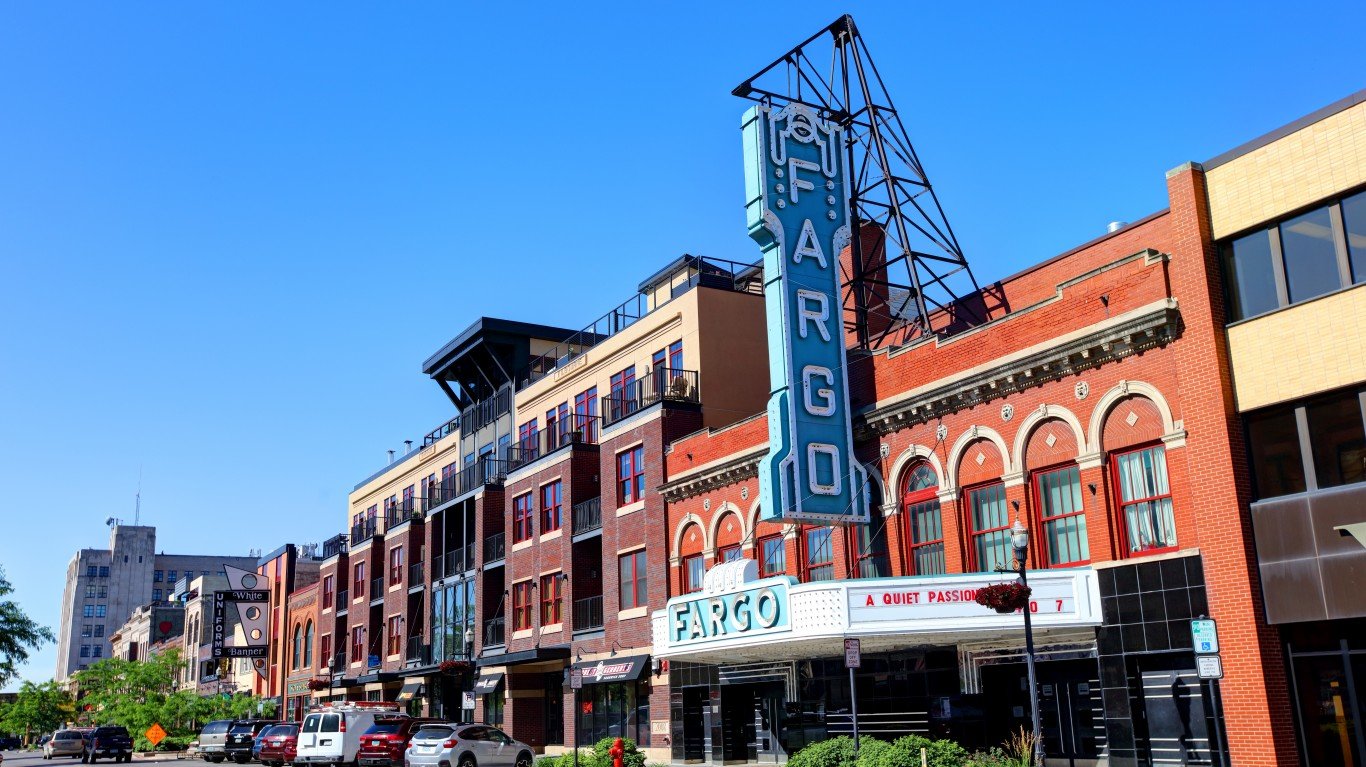
North Dakota: Fargo
> 2019 property crimes per 100,000 people: 3,122 (state: 1,246)
> Number of property crimes in 2019: 3,978 (26.4% of state total)
> Burglaries in 2019: 830 (31.8% of state total)
> Vehicle thefts in 2019: 391 (21.8% of state total)
> Poverty rate: 13.2% (state: 10.7%)
Fargo has the highest property crime rate in North Dakota. There were 3,978 property crimes committed in the city in 2019, or 3,122 for every 100,000 people. For reference, the statewide property crime rate stands at 1,246 per 100,000.
Burglary, a specific category of property crime, is especially common in Fargo. Though the city is home to 16.7% of North Dakota’s population, 31.8% of burglaries in the state in 2019 were committed in Fargo.

Ohio: Chillicothe
> 2019 property crimes per 100,000 people: 7,268 (state: 2,940)
> Number of property crimes in 2019: 1,575 (0.7% of state total)
> Burglaries in 2019: 183 (0.4% of state total)
> Vehicle thefts in 2019: 55 (0.3% of state total)
> Poverty rate: 18.8% (state: 14.0%)
Chillicothe has by far the highest property crime rate in Ohio and one of the highest nationwide. Some 7,238 property crimes were committed for every 100,000 people in the city in 2019, more than double the state property crime rate of 2,940 per 100,000 — which itself is well above the comparable national rate.
Other more serious crimes like robbery and homicide are also more concentrated in Chillicothe than they are across the state as a whole. With a violent crime rate of 475 incidents per 100,000 people, Chillicothe is one of the more dangerous cities in the state. For context, there were 293 violent crimes for every 100,000 people in Ohio in 2019.

Oklahoma: Tulsa
> 2019 property crimes per 100,000 people: 5,311 (state: 2,169)
> Number of property crimes in 2019: 21,336 (19.0% of state total)
> Burglaries in 2019: 4,846 (18.2% of state total)
> Vehicle thefts in 2019: 3,033 (22.7% of state total)
> Poverty rate: 19.4% (state: 15.7%)
Tulsa police recorded a total of 21,336 property crimes in 2019 — or 5,311 for every 100,000 people, more than any other city in Oklahoma. Meanwhile, the state’s property crime rate of 2,169 incidents per 100,000 people is closely in line with the national average.
Motor vehicle theft, a specific category of property crime, is especially common in Tulsa. Though the city is home to just 10.2% of Oklahoma’s population, 22.7% of the vehicles stolen in the state in 2019 were stolen in Tulsa.
[in-text-ad-2]

Oregon: Roseburg
> 2019 property crimes per 100,000 people: 5,736 (state: 1,897)
> Number of property crimes in 2019: 1,345 (1.2% of state total)
> Burglaries in 2019: 151 (1.0% of state total)
> Vehicle thefts in 2019: 110 (0.7% of state total)
> Poverty rate: 12.7% (state: 13.2%)
Oregon’s property crime rate of 1,897 per 100,000 is slightly below the comparable national rate. However, in some parts of the state, property crime is far more common. In Roseburg, located in southwestern Oregon, there were 5,736 property crimes for every 100,000 people in 2019, more than any other city or town in the state.
As is the case nationwide, larceny-theft is by far the most commonly reported crime in Roseburg. About four in every five property crimes committed in the city in 2019 were larceny cases. The remaining incidents were either burglary or motor vehicle theft.
Pennsylvania: Pottstown
> 2019 property crimes per 100,000 people: 3,105 (state: 3,113)
> Number of property crimes in 2019: 705 (0.4% of state total)
> Burglaries in 2019: 108 (0.5% of state total)
> Vehicle thefts in 2019: 41 (0.3% of state total)
> Poverty rate: 18.8% (state: 12.4%)
Pottstown, Pennsylvania, is a small municipality of about 23,000 residents in the southeastern corner of the state. Though it has the highest property crime rate of any city or town in the state home to at least 20,000 people, the local property crime rate is closely in line with the comparable rate across the state as a whole. There were 3,105 known property crimes for every 100,000 people in Pottstown in 2019, compared to 3,113 per 100,000 across all of Pennsylvania.
Still, both Pottsville and Pennsylvania as a whole have a considerably higher property crime rate than the national average.
[in-text-ad]

Rhode Island: Providence
> 2019 property crimes per 100,000 people: 3,011 (state: 1,734)
> Number of property crimes in 2019: 5,413 (33.3% of state total)
> Burglaries in 2019: 715 (30.8% of state total)
> Vehicle thefts in 2019: 474 (34.9% of state total)
> Poverty rate: 25.5% (state: 12.4%)
Property crime is generally less common in Rhode Island than it is across the U.S. as a whole. Still, there are parts of the state where this is not the case. In Providence, the property crime rate stands at 3,011 incidents per 100,000 people, compared to the statewide rate of 1,734 per 100,000.
Property crimes are typically committed for monetary gain, and many Providence residents are struggling financially. The local poverty rate of 25.5% is well above both the 12.4% state and 13.4% national poverty rates.

South Carolina: Myrtle Beach
> 2019 property crimes per 100,000 people: 11,234 (state: 1,771)
> Number of property crimes in 2019: 3,916 (2.6% of state total)
> Burglaries in 2019: 304 (1.1% of state total)
> Vehicle thefts in 2019: 228 (1.5% of state total)
> Poverty rate: 21.6% (state: 15.2%)
Myrtle Beach is a city along South Carolina’s Atlantic coast. Popular tourist destinations like Myrtle Beach can often have inflated crime rates as visitors can be both the victims and perpetrators of criminal activity but are not counted in the population total. Of the 23 cities in South Carolina that are tracked by the FBI and are home to at least 20,000 people, Myrtle Beach has the highest property crime rate. There were 11,234 incidents reported for every 100,000 people in 2019, more than six times greater than the statewide property crime rate of 1,771 per 100,000.
As is often the case in areas with high property crime rates, Myrtle Beach also has a high poverty rate. Across the city, 21.6% of the population live below the poverty line, compared to 15.2% of the state population and 13.4% of all Americans.

South Dakota: Rapid City
> 2019 property crimes per 100,000 people: 3,214 (state: 1,373)
> Number of property crimes in 2019: 2,454 (15.7% of state total)
> Burglaries in 2019: 488 (18.4% of state total)
> Vehicle thefts in 2019: 320 (18.2% of state total)
> Poverty rate: 16.2% (state: 13.1%)
There are five municipalities in South Dakota with populations of at least 20,000 and crime rates that are tracked by the FBI. Of them, Rapid City’s property crime rate of 3,214 incidents per 100,000 people is the highest. Across the state as a whole, the property crime rate is far lower, at 1,373 incidents per 100,000.
Burglary, a specific category of property crime, is especially common in Rapid City. Though the city is home to just 8.6% of South Dakota’s population, 18.4% of burglaries in the state in 2019 were committed in Rapid City.
[in-text-ad-2]

Tennessee: Memphis
> 2019 property crimes per 100,000 people: 6,128 (state: 2,653)
> Number of property crimes in 2019: 39,860 (22.0% of state total)
> Burglaries in 2019: 7,833 (26.2% of state total)
> Vehicle thefts in 2019: 4,046 (21.1% of state total)
> Poverty rate: 25.1% (state: 15.2%)
The property crime rate in Memphis of 6,128 incidents per 100,000 people is the highest of any city or town considered in Tennessee and more than double the state property crime rate of 2,653 per 100,000 — which itself is well above the comparable national rate.
Not only are property crimes relatively common in Memphis, but so too are more serious, violent offences like robbery and homicide. There were 1,901 violent crimes for every 100,000 people in Memphis in 2019 — many times more than both the state and national violent crime rates, which stand at 595 per 100,000 and 367 per 100,000, respectively.
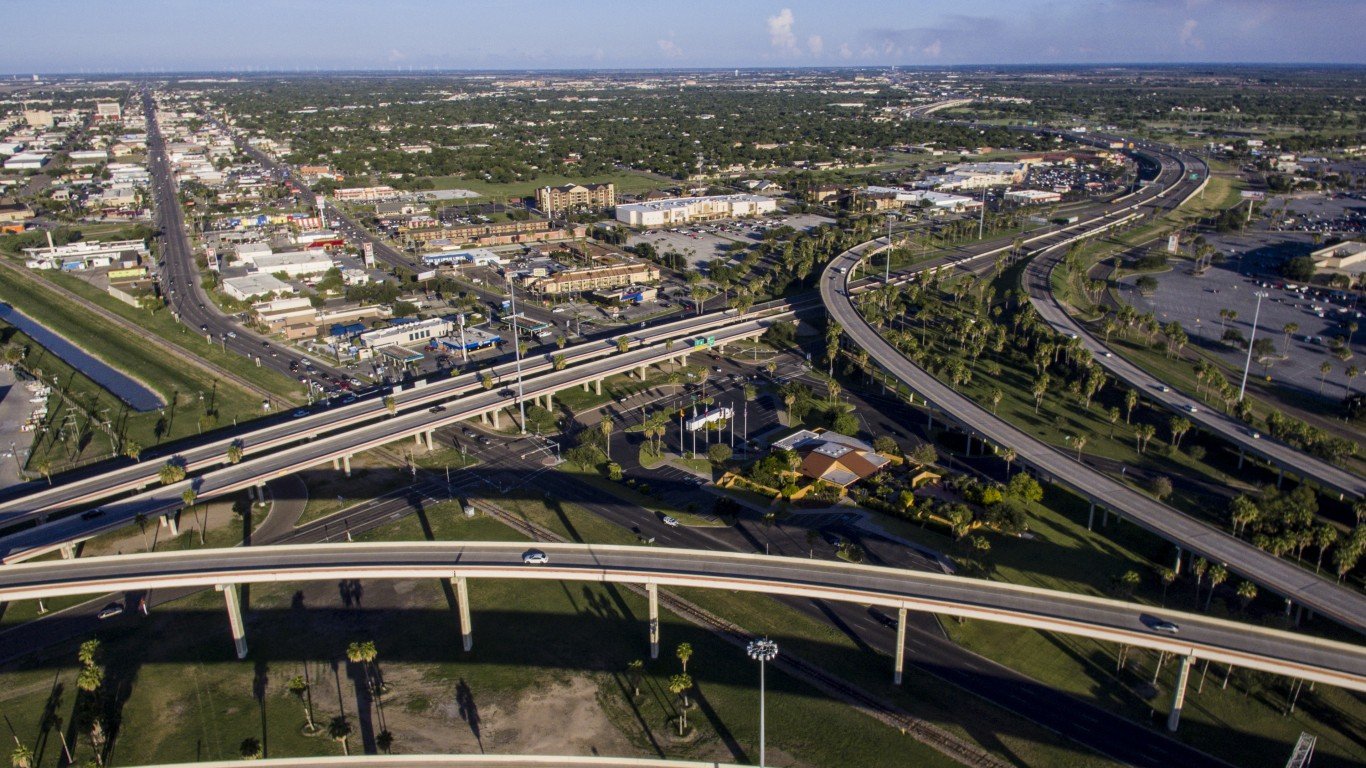
Texas: Harlingen
> 2019 property crimes per 100,000 people: 4,814 (state: 2,357)
> Number of property crimes in 2019: 3,152 (0.5% of state total)
> Burglaries in 2019: 443 (0.4% of state total)
> Vehicle thefts in 2019: 96 (0.1% of state total)
> Poverty rate: 29.1% (state: 14.7%)
Harlingen, a city of about 65,500 residents near the southern tip of Texas, is the only city or town in the state that is home to at least 20,000 people with a property crime rate more than double the state average. There were 4,814 property crimes reported for every 100,000 people in 2019, compared to the statewide property crime rate of 2,357 per 100,000.
As is often the case in areas with high property crime rates, Harlingen also has a high poverty rate. Across the city, 29.1% of the population live below the poverty line, compared to 14.7% of the state population and 13.4% of all Americans.
[in-text-ad]

Utah: South Salt Lake
> 2019 property crimes per 100,000 people: 7,285 (state: 1,220)
> Number of property crimes in 2019: 1,865 (2.7% of state total)
> Burglaries in 2019: 255 (2.9% of state total)
> Vehicle thefts in 2019: 350 (5.2% of state total)
> Poverty rate: 18.7% (state: 9.8%)
South Salt Lake City, Utah, a city of about 26,000 adjacent to the state capital, has far and away the highest property crime rate in the state. There were 7,285 known incidents of property crime for every 100,000 people in the state in 2019, nearly six times greater than the comparable statewide rate of 1,220 per 100,000.
Motor vehicle theft, a specific category of property crime, is especially common in South Salt Lake. Though the city is home to just 0.8% of Utah’s population, 5.2% of the vehicles stolen in the state in 2019 were stolen in South Salt Lake.

Vermont: Burlington
> 2019 property crimes per 100,000 people: 2,584 (state: 2,841)
> Number of property crimes in 2019: 1,110 (12.5% of state total)
> Burglaries in 2019: 109 (8.5% of state total)
> Vehicle thefts in 2019: 25 (8.4% of state total)
> Poverty rate: 26.4% (state: 10.9%)
Vermont is a relatively small and rural state. As a result, there are only two municipalities in the state that are home to at least 20,000 people and where the FBI tracks crime statistics — Burlington and Essex. Of the two, Burlington has the higher property crime rate, at 2,584 incidents per 100,000, compared to 1,288 per 100,000 in Essex.
With so much of Vermont’s population living outside cities, most property crime does not occur in cities. In fact, even though Burlington has the highest property crime rate of any moderately sized city in the state, it still has a lower property crime rate than the state as a whole, where there were 2,841 reported property crimes for every 100,000 people in 2019.

Virginia: Portsmouth
> 2019 property crimes per 100,000 people: 5,861 (state: 2,376)
> Number of property crimes in 2019: 5,509 (3.9% of state total)
> Burglaries in 2019: 846 (6.1% of state total)
> Vehicle thefts in 2019: 474 (4.6% of state total)
> Poverty rate: 16.8% (state: 10.6%)
Portsmouth is a city of about 94,000 in southern Virginia, located across the Elizabeth River from Norfolk. There were 5,861 property crimes reported for every 100,000 people in the city in 2019, more than double Virginia’s property crime rate of 2,376 per 100,000.
The city’s high property crime rate is due in large part to the number of burglaries that were reported in 2019. Though Portsmouth is home to only 1.1% of Virginia’s total population, 6.1% of the 13,900 burglaries reported in the state were committed in the city.
[in-text-ad-2]

Washington: Tukwila
> 2019 property crimes per 100,000 people: 16,390 (state: 2,146)
> Number of property crimes in 2019: 3,350 (1.6% of state total)
> Burglaries in 2019: 189 (0.5% of state total)
> Vehicle thefts in 2019: 480 (2.0% of state total)
> Poverty rate: 17.2% (state: 10.8%)
Tukwila has by far the highest property crime rate in Washington state — and also the highest of any city or town home to at least 20,000 people in the entire country. There were 16,390 known property crimes committed for every 100,000 people in the city in 2019, more than seven times the comparable state property crime rate of 2,146 per 100,000.
Violent crime is not necessarily more common in areas with high property crime rates. In Tukwila, however, the violent crime rate stands at 773 incidents per 100,000 people, a rate that is more than double Washington’s violent crime rate of 294 per 100,000.

West Virginia: Huntington
> 2019 property crimes per 100,000 people: 3,923 (state: 1,471)
> Number of property crimes in 2019: 1,792 (6.3% of state total)
> Burglaries in 2019: 456 (7.7% of state total)
> Vehicle thefts in 2019: 189 (7.8% of state total)
> Poverty rate: 32.3% (state: 17.6%)
West Virginia is a relatively small and rural state. As a result, there are only two municipalities in the state that are home to at least 20,000 people and where the FBI tracks crime statistics — Huntington and Morgantown. Of the two, Huntington has the higher property crime rate, at 3,923 incidents per 100,000, compared to 1,563 per 100,000 in Morgantown. Meanwhile, West Virginia’s property crime rate of 1,471 per 100,000 is lower than in either of the two cities.
Property crimes are typically committed for monetary gain, and many in Huntington are struggling financially. The local poverty rate of 32.3% is well above both the 17.6% state and 13.4% national poverty rates.
[in-text-ad]
Wisconsin: Superior
> 2019 property crimes per 100,000 people: 4,240 (state: 1,950)
> Number of property crimes in 2019: 1,101 (1.3% of state total)
> Burglaries in 2019: 122 (1.0% of state total)
> Vehicle thefts in 2019: 61 (0.8% of state total)
> Poverty rate: 14.1% (state: 11.3%)
Superior is the only city in Wisconsin, home to at least 20,000 people, with a property crime rate that is more than double the comparable state rate. There were 4,240 property crimes reported for every 100,000 people in Superior in 2019, well above the rate of 1,950 per 100,000 across Wisconsin as a whole.
As is the case nationwide, larceny-theft is by far the most commonly reported crime in Superior. More than four in every five property crimes committed in the city in 2019 were larceny cases. The remaining incidents were either burglary or motor vehicle theft.
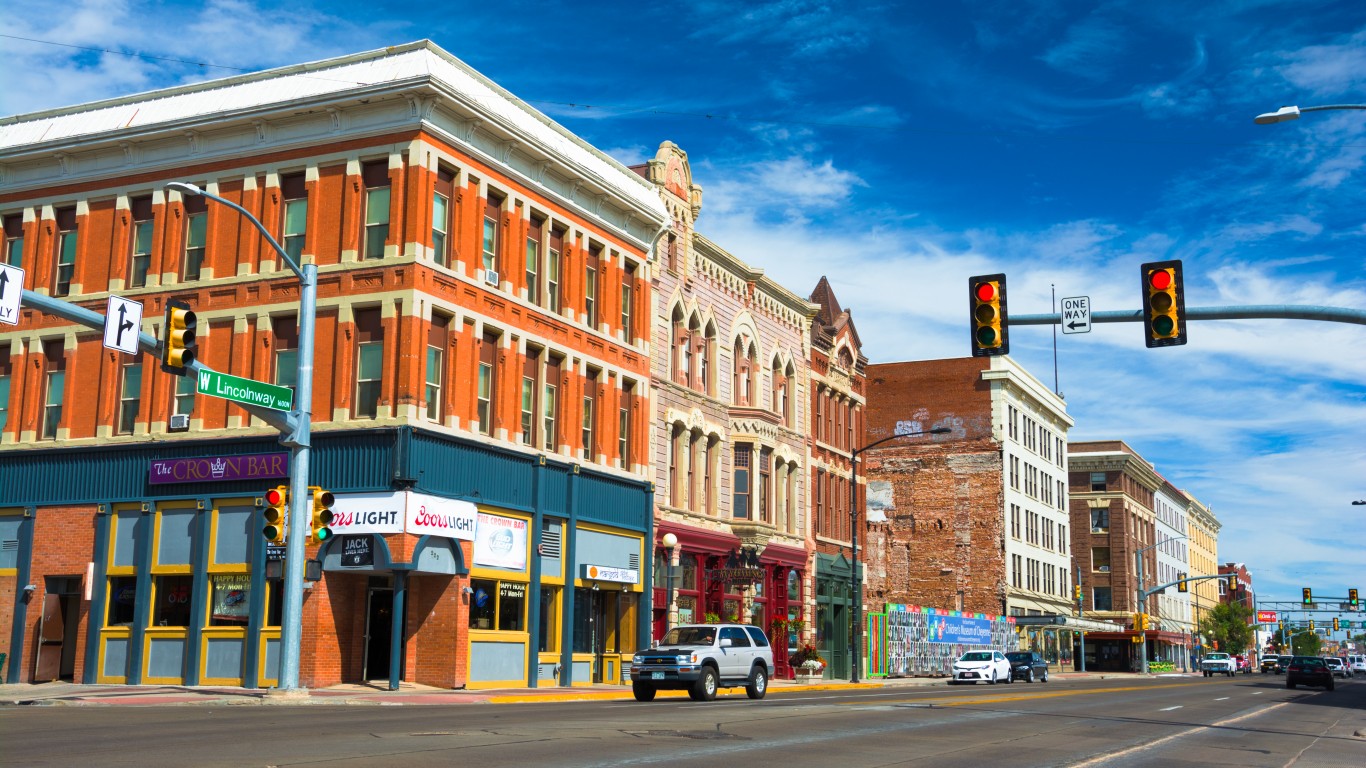
Wyoming: Cheyenne
> 2019 property crimes per 100,000 people: 3,099 (state: 2,376)
> Number of property crimes in 2019: 1,999 (22.0% of state total)
> Burglaries in 2019: 211 (15.1% of state total)
> Vehicle thefts in 2019: 175 (24.5% of state total)
> Poverty rate: 10.4% (state: 11.0%)
There are five municipalities in Wyoming with populations of at least 20,000 and crime rates that are tracked by the FBI. Of them, Cheyenne’s property crime rate of 3,099 incidents per 100,000 people is the highest. Across the state as a whole, the property crime rate is far lower, at 1,999 incidents per 100,000.
The city’s high property crime rate is due in large part to the large number of motor vehicle thefts that were committed in 2019. Though Cheyenne is home to only 11.1% of Wyoming’s total population, 24.5% of the 713 motor vehicle thefts reported in the state were committed in the city.
Take This Retirement Quiz To Get Matched With A Financial Advisor (Sponsored)
Take the quiz below to get matched with a financial advisor today.
Each advisor has been vetted by SmartAsset and is held to a fiduciary standard to act in your best interests.
Here’s how it works:
1. Answer SmartAsset advisor match quiz
2. Review your pre-screened matches at your leisure. Check out the
advisors’ profiles.
3. Speak with advisors at no cost to you. Have an introductory call on the phone or introduction in person and choose whom to work with in the future
Take the retirement quiz right here.
Thank you for reading! Have some feedback for us?
Contact the 24/7 Wall St. editorial team.
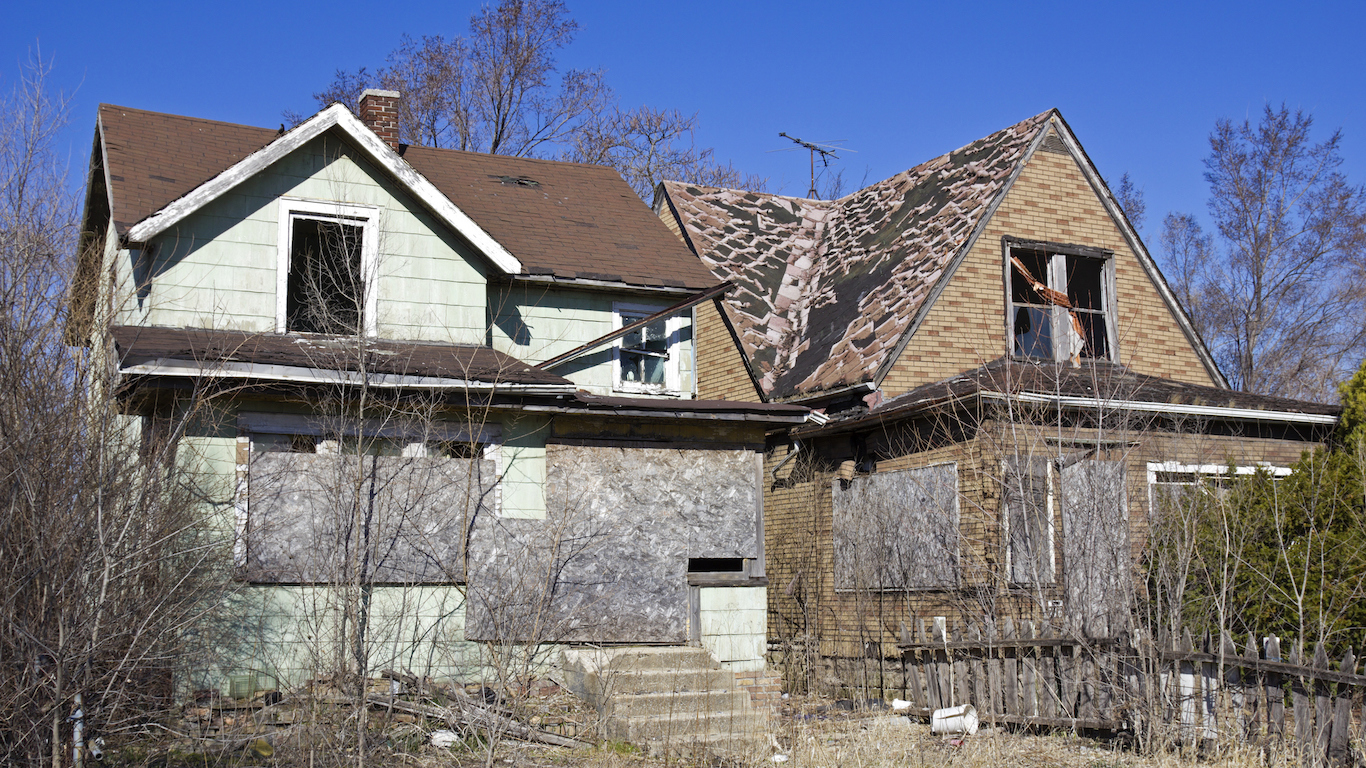 24/7 Wall St.
24/7 Wall St.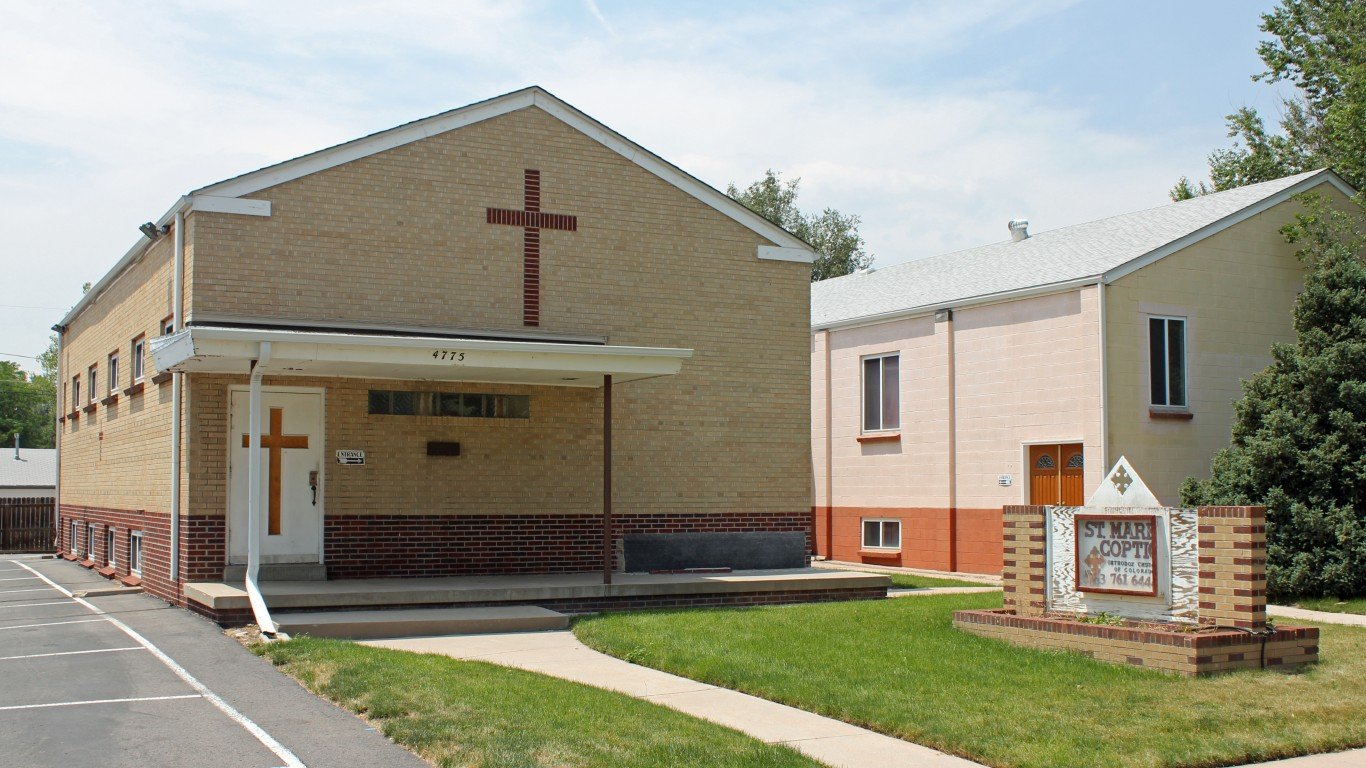
 24/7 Wall St.
24/7 Wall St.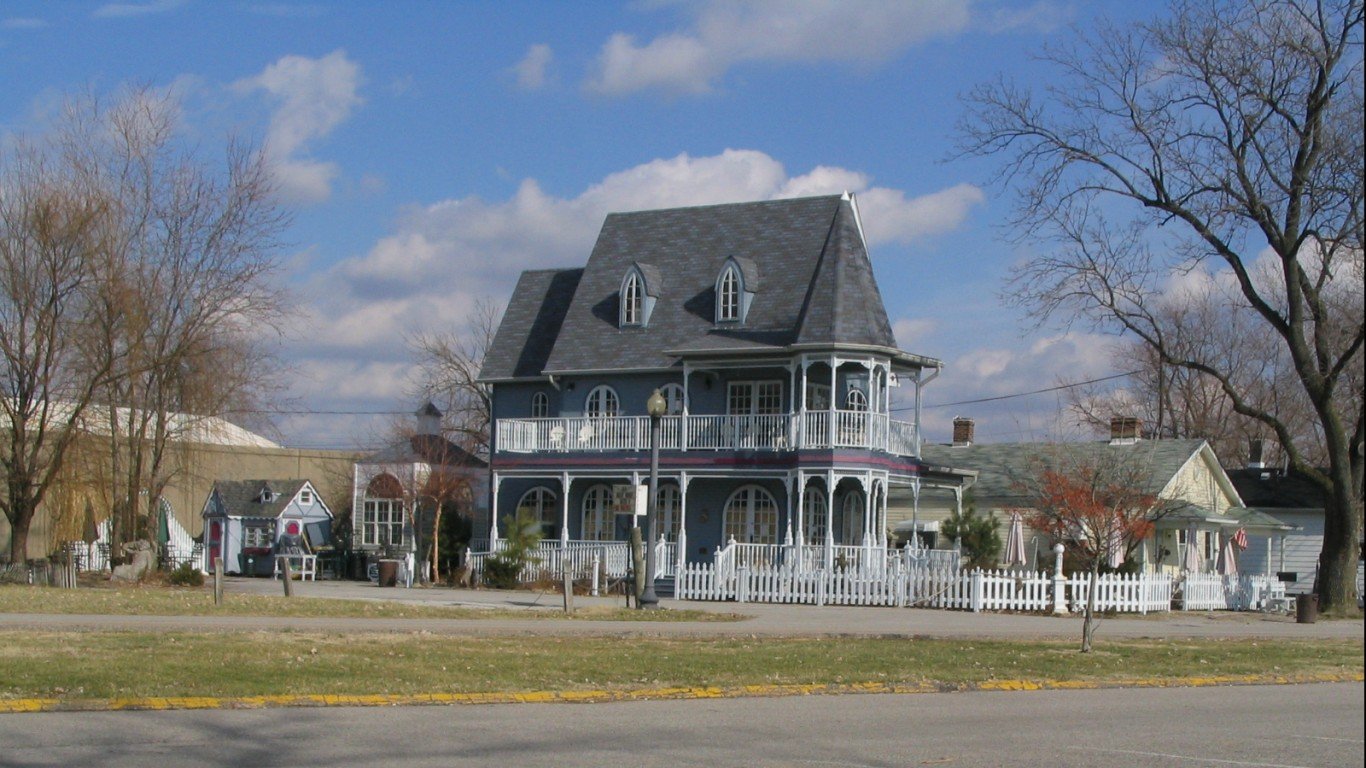
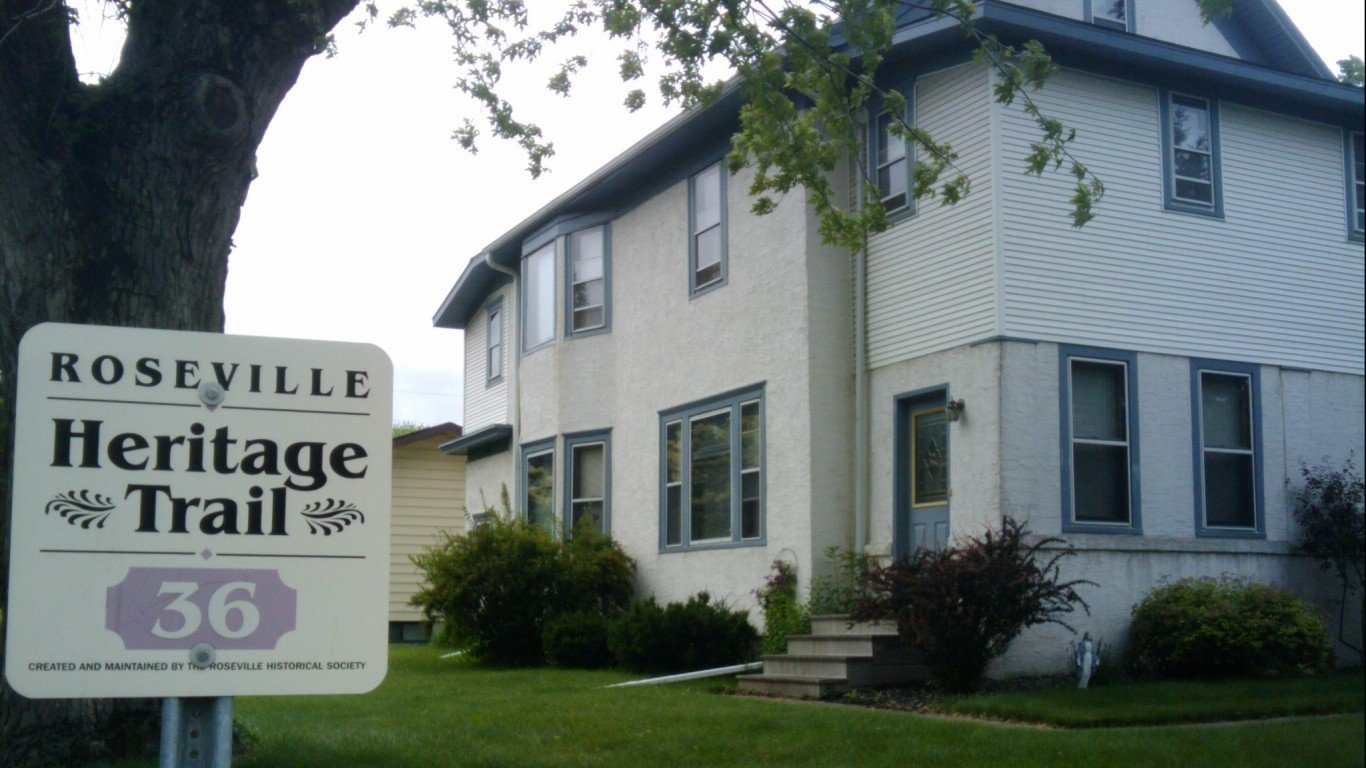
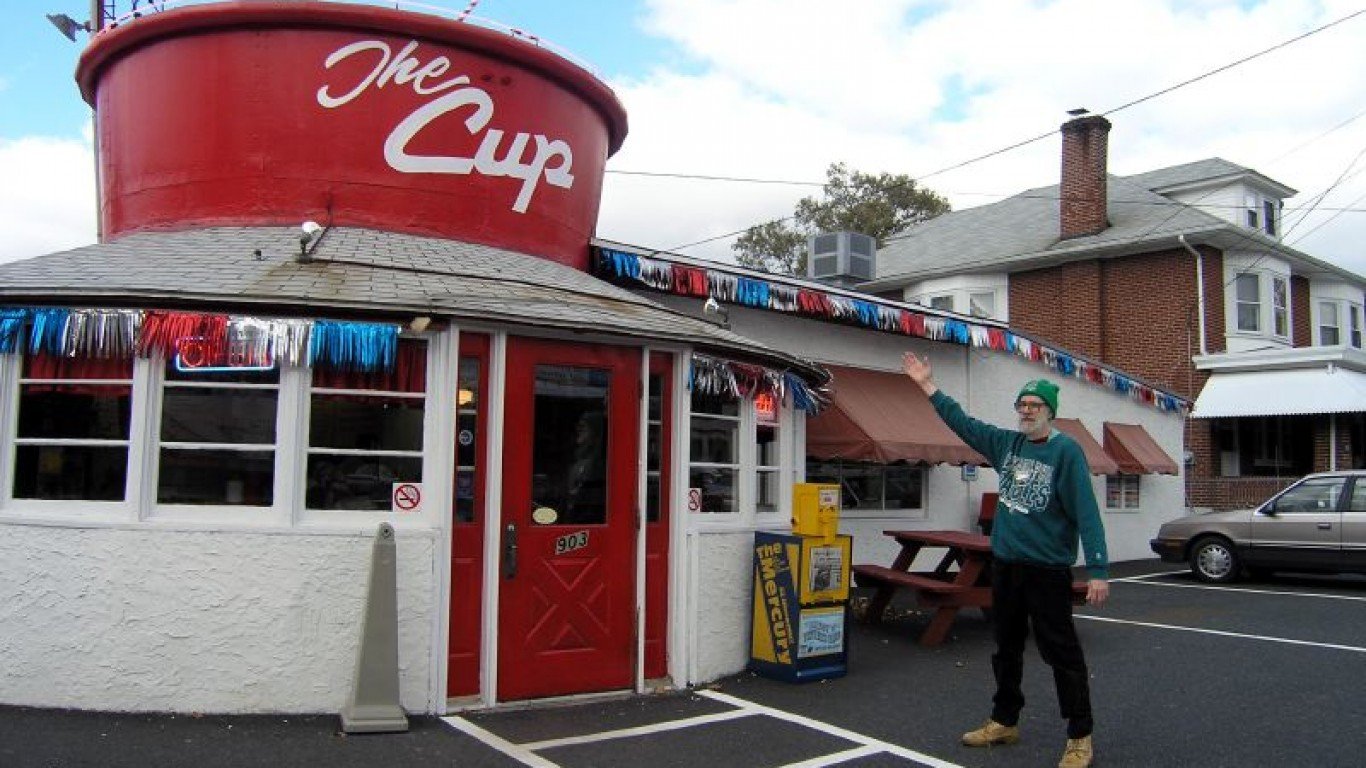
 24/7 Wall St.
24/7 Wall St.
 24/7 Wall St.
24/7 Wall St.

